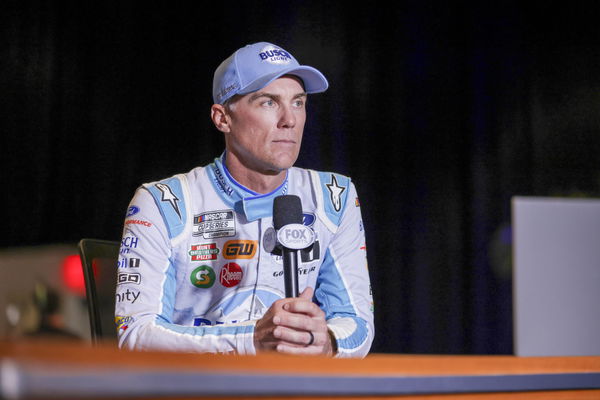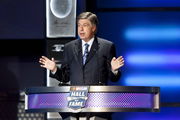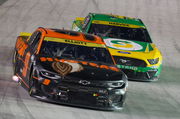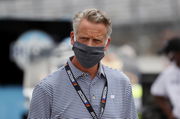
via Getty
DAYTONA, FL – FEBRUARY 16: Kevin Harvick, driver of the #4 Busch Light #BUSCHRACETEAM Stewart-Haas Racing Ford Mustang, fields questions from the media during Daytona 500 Media Day on February 16, 2022 at Daytona International Speedway in Daytona Beach, Fl. (Photo by David Rosenblum/Icon Sportswire via Getty Images)

via Getty
DAYTONA, FL – FEBRUARY 16: Kevin Harvick, driver of the #4 Busch Light #BUSCHRACETEAM Stewart-Haas Racing Ford Mustang, fields questions from the media during Daytona 500 Media Day on February 16, 2022 at Daytona International Speedway in Daytona Beach, Fl. (Photo by David Rosenblum/Icon Sportswire via Getty Images)
The GEICO 500 race at Talladega had flashes of the 2022 playoff event when the Next Gen car was in its debut season. NASCAR claimed that the new design and structure of the race car were well-equipped with improved safety mechanisms. But multiple wrecks and concussions to drivers like Alex Bowman and Kurt Busch posed serious concerns about the race car.
It even prompted Chase Elliott to question NASCAR’s new brainchild, stating, “I just hate to see us go backwards, and I’m afraid that we have.” And even after two years, the safety concerns have just not been addressed, as Erik Jones suffered a compression fracture in his back. Kevin Harvick, who now has a broader perspective on the sport from his time in the FOX booth, made an urgent plea for NASCAR to intervene.
ADVERTISEMENT
Article continues below this ad
Kevin Harvick highlights the severity of crashes inside the Next Gen car
Viewing Erik Jones’s crash in real time on TV didn’t seem like it was a big deal. However, the perspective changes, when the camera footage from the inside of the car is revealed. It shows how the driver took a nasty hit, which resulted in him injuring his lower back. For a racecar that was supposed to be an improvement over its predecessors, it has to do a better job of protecting the driver. But unfortunately, that hasn’t been the case so far, especially on superspeedways.
Sharing his view on the crash, Harvick in his latest episode of the Happy Hour podcast explained why the Gen7 car hits are brutal on the drivers. “The Josh Berry incident, the Corey LaJoie incident, those cars, when they get up in the air like that and slam back into the ground, it feels like somebody just takes a punch and hammers it right through your spine. It is violent, Erik Jone’s hit was violent.”
He even tried to detail the reason behind the Next Gen car’s impact during the crash and how it affected the drivers inside the car. “So basically, when you hit something now, it’s like it happens so fast, like in a whiplash situation, it just happens a lot faster because a lot of that impact is going through your body because the whip is whipped faster. I guess is the one way to explain it. It just becomes much more violent for the driver.”
ADVERTISEMENT
Article continues below this ad
Harvick also singled out an issue with the new Camry that can potentially result in disastrous outcomes late in the race.
Trending
The Toyota Camry is the worst car for drivers to make the push
Pushing is the norm when drivers compete in speedway races. What it does is allow the energy of the whole pack to tail the lead car and bump it further. Martin Truex Jr did exactly that by helping Tyler Reddick get his win. However, it was clear that the Fords had an edge over the Camry when it came to pushing, and had it not been for Michael McDowell’s spin, there would have been a Ford car in victory lane.
ADVERTISEMENT
Article continues below this ad
Highlighting a major flaw on the new Camry XSE, Kevin Harvick opined, “I think their cars don’t seem to be able to be pushed as well as the Fords for sure. It seems like they are the worst cars to push. Last year they fixed the front of their Camry, this year to make it flat so they could be a good pusher, but it just doesn’t seem like they’ve got the back of the car settled.”
The Next Gen car is already not a favorite among the drivers in NASCAR garages. An incident like this will only push for more demands or changes in racing packages for future events.
ADVERTISEMENT
ADVERTISEMENT
ADVERTISEMENT
ADVERTISEMENT






